Russian cuisine is just as diverse and vast as the large size of the country. The dishes and their taste actually differ depending on the district of the country with more than 150 nationalities living on its territory.
The main feature of traditional Russian cuisine is determined of course by the lifestyle of the Russian people. Russia throughout the centuries has been an agricultural country with the majority of the population being peasants. The center of the Russian house has always been the stove as the source of heat and the place for cooking. This is what influenced the way food was prepared.
Appetizers
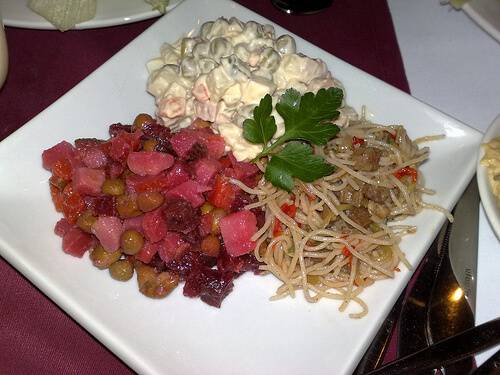
Among the appetizers that are extremely popular include all kinds of pickled vegetables: cabbage, cucumbers – and even garlic, which is absolutely delicious! As the season for growing vegetables was usually rather short, – less than six months in some districts – people pickled vegetables to make them last through the winter. Pickled mushrooms and cabbage are amazing with vodka – the most traditional and famous Russian alcoholic drink. They also serve as a base for some salads among them being a fantastic vegetarian salad called Vinegret, which is very popular even nowadays and is always a part of a festive meal.
To make a Vinegret you need: 1 cooked beetroot, 1-2 cooked carrots, 4-5 cooked potatoes, 3 pickled cucumbers, 100g pickled cabbage, 50g green onion, 4-5 spoons oil, 4 spoons of pees. Mix your ingredients and enjoy a delicious beetroot salad!
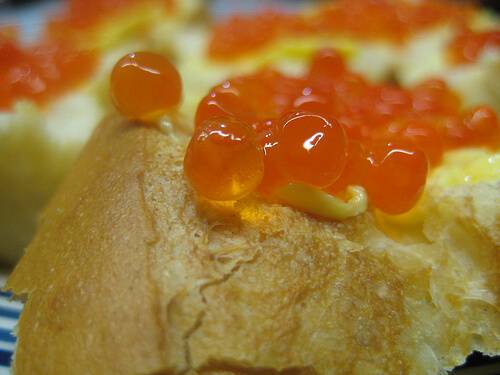
Another traditional appetizer that is popular during Christmas and New Year is caviar. Nowadays black caviar is very expensive so Russian people eat red caviar. It is usually eaten on white bread with butter.
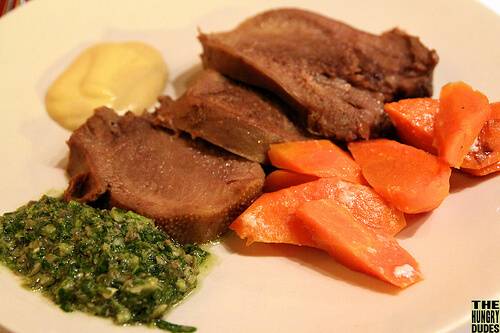
Besides caviar Russian people loved boiled pork and cow tongue. This is eaten with a spicy horseradish sauce and is also very popular during holidays.
Soups
Soups have always played a vital part in the life of peasants for it was the main dish, it was very rich and – what was more important in the Russian northern climate – it was hot. None of the cuisines in the world can boast of having such a variety of soups. Even nowadays Russians eat many soups. No wonder that the most well-known Russian dish in the world is of course the Borscht (beetroot soup). Shchi (cabbage soup) is also very common. Borscht is considered to be more a dish of southern Russia, even Ukraine, and Shchi is definitely a more northern dish. Both of the soups you can easily find on the menu in most Russian restaurants.
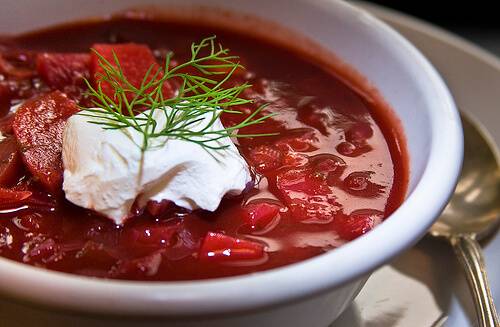
There are different varieties of borscht, but they have one thing in common – and that is of course the beets! Here is a recipe for a so-called Moscow borscht. You will need 500g of pork, 1 beetroot, 300g of cabbage, 1-2 carrots, 1 onion, 2 spoons of tomato souse, 4 teaspoons of sugar, 1-2 spoons of 3% vinegar, 2 sausages, 100g of ham, some sour cream.
Cook a broth from pork (about 1.5 hours)
With a use of grater cut the beetroot and stew it in a pan with oil, tomato souse, vinegar, sugar and some broth.
Separately fry a little onion with carrots in a pan.
Add cabbage, carrots and onion to the broth. Cook for 10 minutes.
Add the beetroot, cut sausages and ham to the broth, make the broth boil.
The ready borsch serve on plates with herbs and sour cream. Bon appetite!
Main dishes
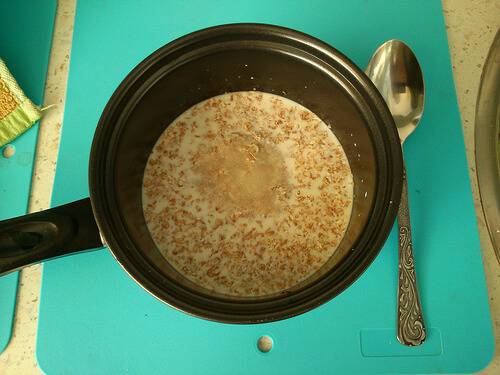
Since Russia has always been an agricultural country, the most common food was vegetables and grains. Hence the second most popular Russian dish – and the second most important after soups – was «kasha» (or porridge). Buckwheat porridge is considered to be very special. Usually butter is added into the porridge or different kinds of dairy products. One of the most important sauces is sour cream, which you can put into soups, vegetables – in fact into everything. Therefore, if you want a Russian-style party, you can just buy sour cream and add it to all the dishes! It will make them almost Russian.
In addition, a very popular garnish is vegetables. Vegetables were also cooked or stewed in the stove together with meat or fish. Before potatoes became popular (middle of the 19th century), people ate a lot of turnips. Nowadays potatoes are probable the most popular vegetable, but Russians also love to cook pumpkins, marrow squashes that they grow at their dachas (country houses) and eggplants.
Traditionally Russians didn’t eat many meats because of the numerous religious rites that prohibited eating any. Game was rather widely spread because hunting was rather common. It was cooked in a stove as one piece – rabbits, hares, ducks, etc. Usually game was cooked with different berries or fruit like blueberry, cranberry, sour apples and so on.
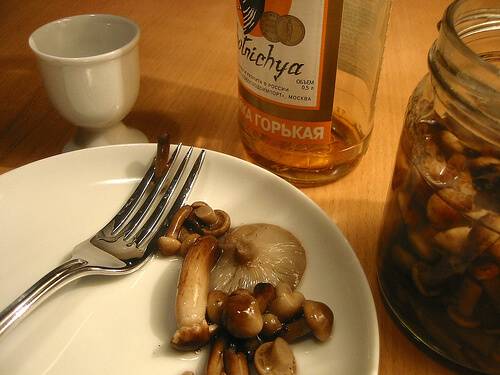
Mushrooms also play an essential part in Russian cuisine. They were fried, stewed and pickled. Mushrooms could be added almost to any dish for flavor or they could be cooked as a separate meal. For example, fried mushrooms with potatoes is still a very popular dish.
Fish dishes are also quite popular. In old Russia they would cook fish soup called ukha from different kinds of fish. Fish soup was prepared in various ways and before the 19th century black caviar used to be so cheap that it was a very common thing to be added in soup.
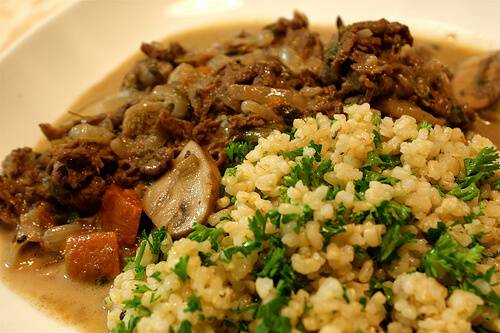
Among the most well-known dishes of Russian cuisine is the famous beef stroganoff. It is a dish of sautéed pieces of beef served in a sauce with sour cream. The dish has a unique history. It was named after a wealthy aristocrat from St Petersburg, Count Stroganoff (if you come to St Petersburg you can still see his baroque-style palace on Nevsky Prospect). According to one of the versions the count’s cook invented the recipe for the “open” dinners when nobody knew exactly how many people would show up. Another legend says that the cook came up with this recipe when the Count became old and couldn’t chew meat anymore.
Here is one of the numerous recipes for beef stroganoff. You will need 50g of onions, 100g of 38% cream, 150g of sour cream and 350g of beef. First you need to cut beef and onions to small pieces, put it into the pan, add salt and pepper and fry it so that it is half-ready. Then you mix cream with sour cream until it becomes smooth, add the sauce into the pan and stew for 7 to 10 more minutes. And enjoy your beef stroganoff!
Desserts
Traditionally as the country was agricultural the main food was always different types of grain. Rye was more for everyday while wheat flour was used to cook different dainty things like pirogi (all sorts of pies with different filling – berries, apples, meat, and fish). And of course the world-famous Russian blini (pancakes) were also made from flour.

Blini appear in Russia even before 9th century. During celebrations to mark the end of winter they used to symbolize the sun, hence there shape. Russian pancakes are very thin, almost transparent, that’s why they easily absorb butter and sour cream which makes them juicy and delicious.

The main desserts in Russia have always been ginger bread and kulich. The first ginger bread appeared in Russia in 11-12th century A.D. as a mixture of rye flour with honey and berry juice. Later people started to add spices into the dough. Among the spices can be cinnamon, cardamom, mint, ginger, cloves, vanilla. Usually Russian ginger bread is covered with glaze.
Kulich is usually baked for the main Russian holiday – Easter. The dough includes cream, butter, sugar, eggs and yeast. Also a traditional kulich must have some raisins or other toppings.
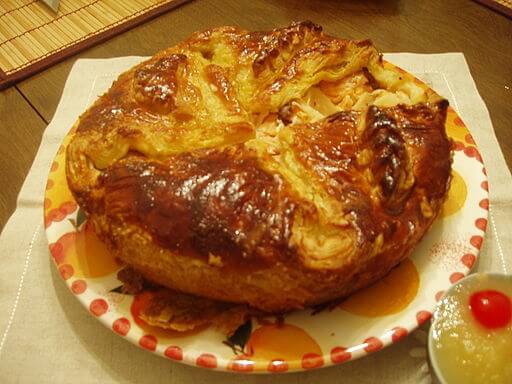
Pirogi is probably also one among the most famous dishes of the Russian desserts. It is a pie with different fillings that can be sweet or rich. In the past not a single feast could take place without pirogis being served. The fillings can include vegetables (like cabbage or carrots), mushrooms, different grains, fish or meat and different berries or fruit.
Here is a recipe for Russian pancakes. You will need 400g of wheat flour, 1 liter of milk, 5 eggs, 2 spoons of sugar, salt and oil for frying.
Mix the eggs with sugar, add slowly salt and flour. Carefully add the milk and mix it to become smooth. Leave the dough for 20 minutes. Then bake the blini on a very hot pan.
Drinks
Almost all the Russian traditional drinks are original and are not to be found in any other cuisine of the world. Among them are sbiten, mors, different honey beers and naturally the most well-known Russian drink is vodka.
Sbiten was drunk in Russia before tea became popular. It’s a hot winter-time drink. It is based on honey mixed with water, spices and jams.
Meads are alcoholic drinks based on honey. They also include different berry juices and spirits, which makes them strong.
Kvass is also very popular even today. It is made from black or regular rye bread.
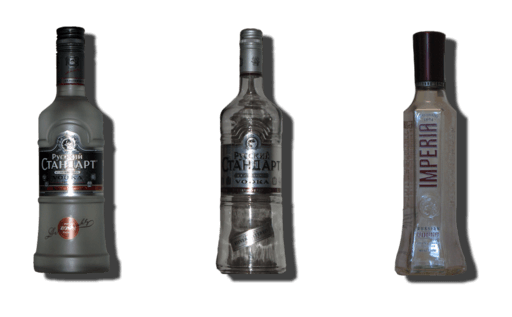
Speaking about vodka, the drink we know today actually was invented around 1894 by Dmitri Mendeleev. Before him there was no standard and vodka could be any strength (nowadays it must be strictly 40% spirit and 60% water).
And mors is a very common drink even today. It is a non-alcoholic drink made from different kinds of berries – usually cowberry or cranberry. Here is a simple recipe how to cook mors at home. You will need a glass of frozen berries (better cranberry), 1 liter of water, cinnamon and some sugar. First boil the water with sugar and cinnamon. Add the berries and a minute later turn off the cooker. After mors cools down, filter it and the drink is ready!
If you would like to learn more about Russian cuisine and Russian lifestyle feel free to contact us! We offer a special evening program “Dinner with a Russian Family” where you can have a once-in-a-lifetime experience and taste the best of Russian cuisine! And our guides will be happy to help you to communicate. In addition, our company offers pre-set Russian cuisine lunches which you can enjoy during your tour of St Petersburg!

